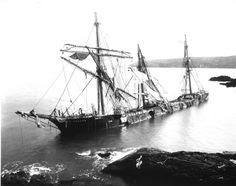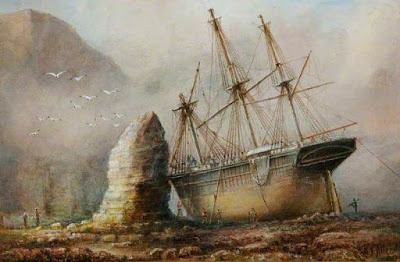The 9th Dawlish Chronicle is available from 12th December 2020. Details at end of article.
Civilian Life – and Death – at sea in the 1870s
It is easy, at this remove, to be entranced by the “romance” of the seaborne trade in the 19th Century, when the numbers of ships grew explosively to satisfy the needs of the first era of commercial globalisation. Images immediately come to mind of clippers racing under full sail to carry tea from China, of square-riggers rising to the challenge of Cape Horn, of the tens of thousands of brigs and schooners which carried oceanic as well as coastal trade, of the early steamers and other ships that were to be immortalised in the writing of Joseph Conrad. The beauty of so many of these ships, even the humblest, and the skill with which they were handled in the absence of any modern aids to navigation, do however tend to blind us to the fact that life on so many of these ships was brutal in the extreme. Looking at life – and death – at sea in the 1870s, a single decades, reinforces this view.

Wreck of the Copeland at South Shields, November 1861, by John Newington Carter
Life in the merchant service was not just nasty and brutal – it could also be very short. Shipwrecks on an annual basis were at levels undreamed of today. The losses off Britain in one year alone is starkly illustrative: in 1873-4, 411 vessels, many small, sank around the British coast, with the loss of 506 lives. Bad seamanship and extreme weather were not responsible in many – perhaps ever a majority – of cases. Ships frequently broke up or fell apart for the simple reason that they were already rotten and worn-out. Standards for structural integrity and for limits on loading had indeed been established as early as 1835 by Lloyd’s Register and compliance was a pre-requisite for insurance by reputable entities associated with Lloyds. There was however no legal requirement to meet such standards and many ship-owners operated vessels that were so unsound that they became known as “Coffin Ships”. Worse still, they were often loaded so heavily as to be incapable of surviving the first serious storm they would encounter.

How it so often ended…
The situation was made even worse by the fact that once a seaman had signed on for a voyage – which on occasion poverty might force him to do without having first seen the ship itself – refusal to board could result in criminal prosecution and imprisonment with hard labour, typically for twelve weeks. In the 1850s a British prison-inspector reported that three-quarters of all prisoners in gaols in England’s south-west were such seamen. Their crime had been to refuse to sail on vessels they believed to be unseaworthy or which were inadequately manned.

Samuel Plimsoll
This was the background to the great crusade for safety at sea waged by the coal-merchant turned activist, Samuel Plimsoll, one of the great Victorian heroes. He entered parliament to fight on this issue in the early 1870s and his efforts were to be finally rewarded by imposition of statutory safety requirements. The most notable was to be the “Plimsoll Line”, still carried on ships’ hulls, which provided visual confirmation that the ship was not over-laden. Legislation was one thing, enforcement of compliance was another, and a battle still lay ahead. A later blog will deal with Plimsoll’s in more detail.
That there was still a long way to go in the 1870s was illustrated by an eyewitness account by the writer, artist and explorer Frederick Whymper (1838-1901) of crew conditions on shipping he saw departing from British ports. He noted that even on many “superior vessels” the seaman “may, and often does, wade to his bunk through water, and the forecastle is too often a miserable hole, full of dirt and filth, where the men are packed like herrings.” Whymper was particularly critical of the food, mainly “salt horse” and hard biscuit of the most inferior type. Even at this late stage scurvy was still often a problem, not least because the lime-juice that should have prevented it was frequently grossly adulterated. Whymper claimed that there was little or no scurvy in the Russian and French merchant navies because of the use of “sour wine” in lieu of lime juice. (It is not clear whether this did indeed have anti-scorbutic properties).

The reality of shipwreck
A major component of British trade was that with the West Indies. A visit to London’s West India Docks, which provided docking for vessels trading to the West Indies, showed Whymper that, though some ships involved were “large and well supplied with provisions”, the majority of the vessels in the trade were “small, with wretched accommodation, badly manned, provisions indifferent in quality and deficient in quantity”. Conditions in the forecastles where the seamen were lodged were horrific, and unhealthy. Cases occurred on “first-class ships” in which seamen’s’ chests were “black from the gas which rises from the cargo, and which smells like sewage, which is especially the case in sugar ships.” A Captain Toynbee told Whymper that he had seen a ship which “was carrying two packs of foxhounds and three horses, which received half its ventilation by a hatch which opened into the sailors’ forecastle.”

Silex Bay, Flamborough by John Taylor Allerston, 1890
Ships engaged in the Baltic trade, most of them carrying timber, tended to have high rates of “consumption, bronchitis, and other chest diseases”. Whymper noted that Norwegian, Swedish and Russian vessels not only provided superior food than their British counterparts, but tended to accommodate the crew not in the forecastle but in deckhouses with “a fair amount of space and good ventilation”. The Scandinavian ships were also apparently cleaner than British ones and Whymper was critical of British crews – “the chief fault is the extremely dirty and lazy habit of the men themselves, who allow filth of all kinds to accumulate in the deck-house and galley, without taking the slightest trouble to remove it.” The tendency to overload appears to be continuing, especially in the case of and bulky, high-volume cargo such as timber so that “the forecastle is very much reduced in size—too much so, considering the number of men that form the crew; these have either to remain on deck exposed to wet and cold, or have to breathe the foul atmosphere of a small forecastle, in which are stowed rusty chains, wet ropes, and all kinds of animal decaying matter.”

Laden collier being towed from harbour at a north-eastern English port
Though much of Britain’s coastal coal trade was bring carried in steamers by the 1870s there were still many sailing craft of 150 to 600 tons, usually rigged as sloops, schooners, or brigs, the latter being the most common. The crews to operate such vessels seem to have been wholly inadequate – which was probably a major factor in many shipwrecks. Whymper wrote that “a collier brig is generally worked by a captain and a mate, who live in a small dirty cabin, and by four men and a boy, who live and sleep in the most miserable of forecastles … so old and ill-constructed are some of these colliers, that in rough weather the forecastle is deluged with water. This condition of things is made much worse by the negligence of the sailor himself, for it seems to be a rule that the cook, instead of throwing over the side of the ship the refuse of material used for food, as dirty water, potato parings, &c., deposits these with great care in some corner of the forecastle. No attention is paid by the captain to the sanitary state of the ship; during the voyage, which is often a rough one, he is engaged in working the vessel, and while she is in harbour he is on shore waiting upon the owners of the vessel, or transacting their business in the Coal Exchange.” 
A collier brig in a North Sea gale – with a crew of seven to cope with it
The conditions could be worse still when disease struck. Whymper claimed that he heard from a sanitary inspector engaged in fighting a cholera epidemic that one cholera-victim was taken ashore from a collier after he had been “lying in his hammock for two days prostrate, and with much vomiting and purging, and during this time the captain, although on board, was not aware of the man’s absence from deck.”
This is a sketch only, but it is a reminder, when we are entranced by depictions of billowing canvas, or when we read of the romance of the age of sail, of what lay beneath the attractive exterior.
Beauty is often only skin deep.
The 9th Dawlish Chronicle will be published on 12th December 2020
Britannia’s Morass
September – December 1884
 I’m pleased to announce that Britannia’s Morass will be available in both Paperback and Kindle formats from 12th December. The Kindle version is available at a reduced pre-order price of $ 2.99 in the United States and £1.99 in the UK, and for currency-adjusted prices in other countries.
I’m pleased to announce that Britannia’s Morass will be available in both Paperback and Kindle formats from 12th December. The Kindle version is available at a reduced pre-order price of $ 2.99 in the United States and £1.99 in the UK, and for currency-adjusted prices in other countries.
Click on https://amzn.to/39oTAWx for the US and on https://amzn.to/3ob14ki for the UK for details of how to pre-order. The paperback will be available on the same date but cannot be pre-ordered.
The story involves mystery, blackmail, espionage and danger at a time when the international power balance is shifting. The secrets of cutting-edge weapons technology are highly prized – and some will stop at nothing to get them . . .
It’s 1884 and Captain Nicholas Dawlish departs for service in the Sudan, as told in Britannia’s Gamble. He leaves his formidable wife Florence to face months of worry about him. She’ll cope by immersing herself, as she’s done before, in welfare work for Royal Navy seamen and their families at Portsmouth.
And life in Britain promises to be humdrum, if worthy, at the start . . .
News of the suicide of a middle-aged widow evokes memories of her kindness when Florence was a servant. Left wealthy by her husband, this lady died a pauper, beggared within a few months, how and by whom, Florence does not know. The widow’s legal executor isn’t interested and the police have other concerns. Lacking close family, she’ll be soon forgotten.
But not by Florence. Someone was responsible and there must be retribution. And getting justice will demand impersonation, guile and courage.
Florence doesn’t hesitate to investigate blackmail and fraud in fashionable London, not suspecting that something far larger is involved. A single wrong decision plunges her into an ever-deepening morass, where loyalty to her country and to seamen who served with her husband raises terrifying dilemmas. Old friends support her but old allies who offer help may have different agendas. In a time of shifting international alliances, in which not all the enemies she faces are British, she can be little more than a pawn. And pawns are often sacrificed . . .
Britannia’s Morass plays out against a backdrop of poverty and opulence, of courtroom drama and French luxury, of subterfuge, deceit, espionage and danger.
This volume also includes the bonus short story Britannia’s Collector, which tells of Nicholas Dawlish’s service as a young naval officer in a gunvessel operating off the coast of South America in 1866.
Below are the nine Dawlish Chronicles novels published to date, shown in chronological order. Click on the banner for more information or on the “BOOKS” tab above. All are available in Paperback or Kindle format and can read at no extra charge by Kindle Unlimited or Kindle Prime Subscribers.
Six free short-stories are available for download to your Kindle. Access them by registering for the Dawlish Chronicles mailing list – just click on the banner below. You’ll be kept updated on new books and will receive other free stories at intervals.


